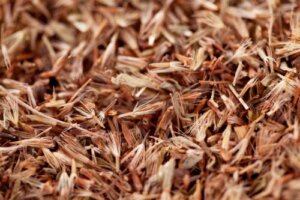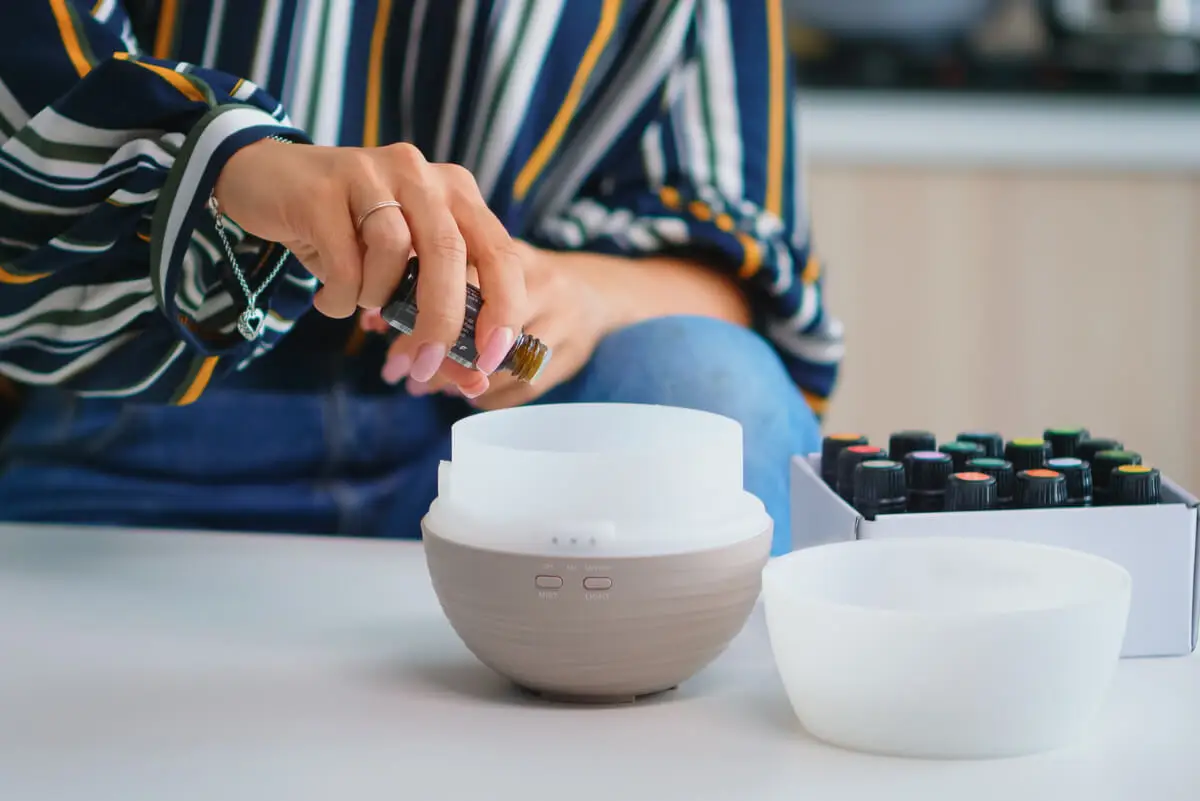Palmarosa Essential Oil: Uses, Benefits, and Tips


Reviewed and approved by the pharmacist Franciele Rohor de Souza
Palmarosa essential oil is a product derived from the plant known as palmarosa cymbopogon martinii. This, in turn, grows in two varieties called “motia” and “sofia,” which differ in fragrance.
Specifically, the oil is extracted from the steam distillation of the dried herb. It’s usually used in the food industry as a flavoring, but it’s also used for cosmetic purposes in the manufacture of perfumes, oils, and soaps.
An article published in the Journal of Pharmacy and Pharmacology states that this ingredient is commonly used in Ayurvedic medicine to soothe skin problems and pain of nervous origin. Beyond this, other properties are also attributed to it. We’ll tell you all about them here!
Palmarosa essential oil: Characteristics and composition
Palmarosa is an evergreen plant that belongs to the Poaceae family. Contrary to what many believe, it’s not related to roses. Its name is due to the fragrance it gives off, which resembles that of roses, but with soft citrus notes.
Its essential oil is characterized by being even more aromatic. Like other oils, its color varies from dark yellow to pale yellow. However, it’s sometimes blended with rose oil to reduce its cost. If so, its quality decreases.
In contrast, its pure form concentrates bioactive substances that are linked to skin and health benefits. According to information shared in the Journal of Essential Oil Research, its main active ingredients are geraniol and geranyl acetate, which confer antioxidant, antimicrobial, anti-inflammatory, and relaxing qualities.
8 uses and benefits of palmarosa essential oil
Palmarosa essential oil is not a product with miraculous properties for health or beauty. Like other naturally occurring substances, it can serve as a wellness supplement. In fact, it has gained popularity for its interesting benefits for skincare and stress reduction. Let’s see what the science says.
1. It can help protect against infections
Due to its concentration of geraniol monoterpene, palmarosa essential oil acts as an antimicrobial and antioxidant essential oil. As suggested by a study shared in Biocatalysis and Agricultural Biotechnology, it may help fight infectious microorganisms such as S. aureus and E. coli bacteria.
Research reported in LWT – Food Science and Technology details that this ingredient is also useful against infections caused by fungi. In particular, it seems to break the membranes of fungal cells, which helps to eliminate them.

2. It helps control total cholesterol and protects the liver
Although more conclusive studies are needed, research in Biochemistry Research International reported that inhalation of palmarosa essential oil was helpful in lowering total cholesterol in rats. In fact, its antioxidants were also observed to combat oxidative stress and prevent liver toxicity.
Like this article? You may also like to read: Bergamot Essential Oil: Benefits and Possible Side Effects
3. It acts as a neuroprotector
In Ayurvedic medicine, this oil is used as a protector of the nervous system, so it’s classified as neuroprotective. In this regard, a study indicates that this oil has positive effects on the prevention of diseases such as Alzheimer’s and dementia.
Also, its calming effects have been shown to be effective in episodes of anxiety and depression. For these purposes, it is often used in aromatherapy.
4. Palmarosa essential oil supports digestive health
The main active compound in palmarosa essential oil, geraniol, has a positive effect on digestive health. To be more precise, it helps inhibit the growth of infectious microorganisms and protects the bacteria that make up the normal microbiota. As research in the International Journal of Molecular Sciences has shown, it also acts as an anti-inflammatory in the gut.
5. It helps skincare
The most widespread uses of this oil have to do with cosmetics. Due to the antimicrobial, anti-inflammatory, and antioxidant effects that come from its geraniol content, some claim that it’s a good treatment for acne, blemishes, and other imperfections.
In fact, a study shared in Future Microbiology comments that geraniol has antimicrobial potential against acne-causing bacteria. Thus, it was determined that topically applied palmarosa essential oil can help fight this skin disease. However, more evidence is still needed.
Even before trying it for this purpose, it’s a good idea to do a small skin test. The reason? It has comedogenic qualities. Therefore, when applied to insensitive and acne-prone skin, it can increase clogging and the presence of blackheads.
6. It improves the appearance of hair
Popular literature suggests that this type of oil improves the appearance of dry hair. Although there’s no evidence for this use, its application from the middle of the hair to the ends may be helpful for split ends, dehydration, and frizz.
Some people massage it into the scalp to promote healthy hair growth. However, this is the same as with the skin. In people with a tendency to excess oiliness, it can be counterproductive. It’s always best to test it beforehand.
7. Palmarosa essential oil can help prevent premature aging
Oxidative stress is often associated with signs of premature aging. However, antioxidants help to counteract these effects. In the case of palmarosa essential oil, a study details positive results on fibroblasts by increasing the production of collagen and hyaluronic acid.
Thus, this oil seems to be useful in the prevention of aging and wound healing. For now, however, more complete studies are needed to corroborate this.
8. It can serve as an insect repellent
For years, palmarosa essential oil has been listed as a natural insect repellent. In fact, a study shared through Acta Tropica reported that it offers 100% protection against mosquitoes for up to 12 hours.
Recommendations for the safe use of palmarosa essential oil
Despite its interesting benefits, this oil can cause some unwanted reactions, especially when used in its pure state or on sensitive skin.
First of all, it’s important to remember that natural products are not always the best for the skin; therefore, it’s best to choose those that are formulated and dermatologically tested. Also, when using them topically, it’s always a good idea to dilute them with a carrier oil or water.
Neither this nor other essential oils are suitable for consumption.
In case of pregnancy, epilepsy, liver damage, or any serious illness, it’s best to consult a doctor or aromatherapy professional before trying this type of oil. The same applies if you’re taking medication.
We think you may be interested in reading this, too: The Incredible Benefits of Frankincense Essential Oil
How to use palmarosa essential oil?
Right now, palmarosa essential oil is present in a wide range of cosmetic products. These are the best option to take advantage of its benefits for the skin since they have safe formulas.
The product is also available undiluted, but it’s not recommended to use it directly on the skin because it can be irritating. If you purchase this presentation, be sure to dilute it in a ratio of 3 drops per tablespoon of carrier oil (15 grams).
To take advantage of the benefits of its fragrance, it can be placed in a diffuser (normal or electric) or in a bottle with cane diffuser rods. Another option is to mix it in a spray bottle with water to spray it in the room or on a pillow.

DIY recipes with palmarosa essential oil
One of the most valued characteristics of palmarosa essential oil is its versatility. As long as it is used in small amounts, it can be added to a number of DIY recipes as a home scent, to repel insects, or to help you relax.
Bearing this in mind, let’s take a look at some DIY recipes with this oil.
Palmarosa essential oil home fragrance
The combination of palmarosa essential oil with grapefruit oil and lavender oil is ideal for refilling cane diffuser bottles. Once you get the blend, you can put it in the bathroom, living room, or any space where you want to enhance the scent.
Ingredients
- 3 drops of palmarosa essential oil
- 4 drops of lavender essential oil
- 3 drops of grapefruit essential oil
- 2 tablespoons of carrier oil of choice (coconut oil, olive, almond, etc.)
Instructions
- Mix all the oils well and put them in the cane diffuser.
- Place it in a strategic spot to disperse its aroma.
- Turn the reeds from time to time to enhance the diffusion.
Homemade insect repellent
If your goal is to avoid mosquito or other insect bites, it’s worth preparing the following natural repellent. Be sure to dilute the essential oils well.
Ingredients
- 3 drops of palmarosa essential oil
- 2 drops of citronella essential oil
- 2 drops of lemongrass essential oil
- 2 tablespoons of carrier oil of choice (such as jojoba, almond, coconut, or avocado oil)
- Water (100 milliliters)
Instructions
- Mix the essential oils well with the carrier oil.
- Then, pour the water into a spray bottle and add the oils as well.
- Spray on the skin and massage to absorb.
- Repeat every 2 hours if you’re outdoors.
A relaxing bath
A relaxing bath with a blend of oils can contribute to the relief of stress and anxiety. Inhaling their aromas has a sedative effect that helps to calm tension and associated ailments.
Ingredients
- 5 drops of palmarosa essential oil
- 4 drops of spearmint essential oil
- 5 drops of geranium essential oil
- 2 tablespoons of carrier oil
Instructions
- Combine all the oils and add them to the bathtub with warm water.
- Then, soak and bathe for 15 to 20 minutes.
What to remember about palmarosa essential oil
Thanks to its content of antimicrobial, anti-inflammatory, and antioxidant active compounds, palmarosa essential oil is considered a good complement to skincare and aromatherapy sessions. Even so, it should be used with caution and always diluted or through diffusers.
All cited sources were thoroughly reviewed by our team to ensure their quality, reliability, currency, and validity. The bibliography of this article was considered reliable and of academic or scientific accuracy.
- Murbach Teles Andrade BF, Conti BJ, Santiago KB, Fernandes Júnior A, Sforcin JM. Cymbopogon martinii essential oil and geraniol at noncytotoxic concentrations exerted immunomodulatory/anti-inflammatory effects in human monocytes. J Pharm Pharmacol. 2014 Oct;66(10):1491-6. doi: 10.1111/jphp.12278. Epub 2014 Jun 16. PMID: 24934659.
- Sarma, P. C., Baruah, P., Pathak, M. G., & Kanjilal, P. B. (1998). Comparision of the Major Components of the Oils of Eight Selections ofCymbopogon martinii(Roxb.) Wats. var.martinii. In Journal of Essential Oil Research (Vol. 10, Issue 6, pp. 673–674). Informa UK Limited. https://doi.org/10.1080/10412905.1998.9701006
-
Jummes, B., Sganzerla, W. G., da Rosa, C. G., Noronha, C. M., Nunes, M. R., Bertoldi, F. C., & Barreto, P. L. M. (2020). Antioxidant and antimicrobial poly-ε-caprolactone nanoparticles loaded with Cymbopogon martinii essential oil. In Biocatalysis and Agricultural Biotechnology (Vol. 23, p. 101499). Elsevier BV. https://doi.org/10.1016/j.bcab.2020.101499
- da Rocha Neto, A. C., Navarro, B. B., Canton, L., Maraschin, M., & Di Piero, R. M. (2019). Antifungal activity of palmarosa (Cymbopogon martinii), tea tree (Melaleuca alternifolia) and star anise (Illicium verum) essential oils against Penicillium expansum and their mechanisms of action. In LWT (Vol. 105, pp. 385–392). Elsevier BV. https://doi.org/10.1016/j.lwt.2019.02.060
- Andrade BF, Braga CP, Dos Santos KC, et al. Effect of Inhaling Cymbopogon martinii Essential Oil and Geraniol on Serum Biochemistry Parameters and Oxidative Stress in Rats. Biochem Res Int. 2014;2014:493183. doi:10.1155/2014/493183
- Ayaz M, Sadiq A, Junaid M, Ullah F, Subhan F, Ahmed J. Neuroprotective and Anti-Aging Potentials of Essential Oils from Aromatic and Medicinal Plants. Front Aging Neurosci. 2017;9:168. Published 2017 May 30. doi:10.3389/fnagi.2017.00168
- Zahra, Aliya Azkia et al. “Review of the Chemical Properties, Pharmacological Properties, and Development Studies of Cymbopogon sp.” (2020).
- Promila. “A review on the medicinal and aromatic Plant-Cymbopogon martinii (Roxb.) Watson (Palmarosa).” International Journal of Chemical Studies 6 (2018): 1311-1315.
- Spisni E, Petrocelli G, Imbesi V, et al. Antioxidant, Anti-Inflammatory, and Microbial-Modulating Activities of Essential Oils: Implications in Colonic Pathophysiology. Int J Mol Sci. 2020;21(11):4152. Published 2020 Jun 10. doi:10.3390/ijms21114152
- Murbach Teles Andrade BF, Nunes Barbosa L, Bérgamo Alves FC, Pereira Marques AF, Albano M, Mores Rall VL, Brüggemann H, Fernandes Júnior A. The impact of Cymbopogon martinii essential oil on Cutibacterium (formerly Propionibacterium) acnes strains and its interaction with keratinocytes. J Pharm Pharmacol. 2018 Dec;70(12):1688-1699. doi: 10.1111/jphp.13011. Epub 2018 Sep 13. PMID: 30277563.
- Mahant S, Sahajpal NS, Nanda S. Insights into the mechanism of Cymbopogan martinii essential oil in topical therapy of acne vulgaris. Future Microbiol. 2021 Oct;16:1181-1193. doi: 10.2217/fmb-2021-0039. Epub 2021 Oct 7. PMID: 34615379.
-
Oliveira, C. R., Bella, L. M., Duarte, M. C., & Vieira, R. de P. (2021). Brazilian essential oil of Cymbopogon martini (Poaceae): positive effects on inflammation-induced human fibroblasts and skin aging. In Revista Fitos (Vol. 15, Issue 4, pp. 444–455). Fiocruz – Instituto de Tecnologia em Farmacos. https://doi.org/10.32712/2446-4775.2021.1127
-
da Silva, M. R. M., & Ricci-Júnior, E. (2020). An approach to natural insect repellent formulations: from basic research to technological development. In Acta Tropica (Vol. 212, p. 105419). Elsevier BV. https://doi.org/10.1016/j.actatropica.2020.105419
This text is provided for informational purposes only and does not replace consultation with a professional. If in doubt, consult your specialist.








